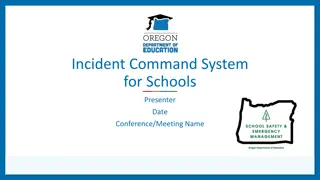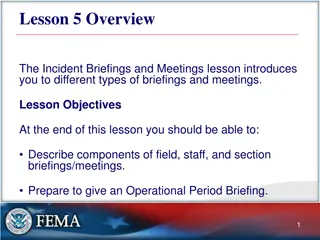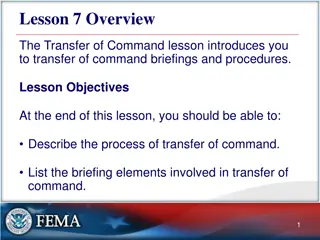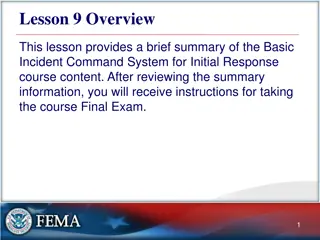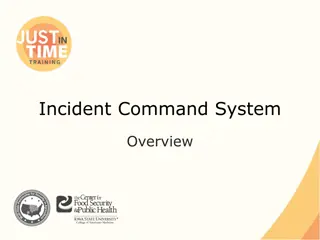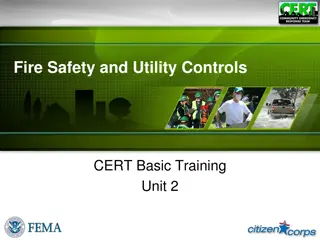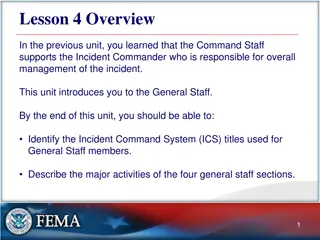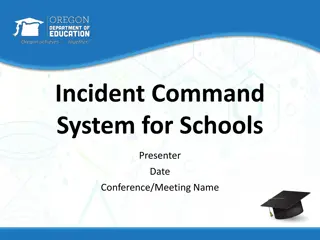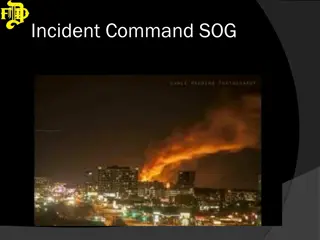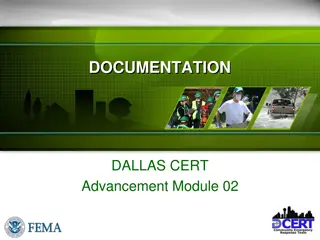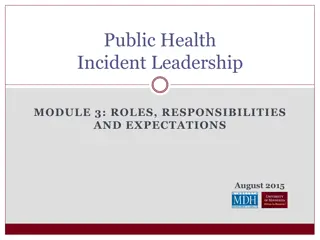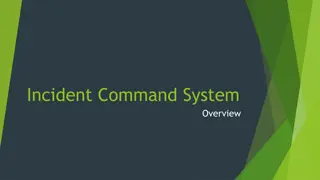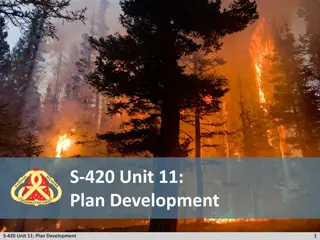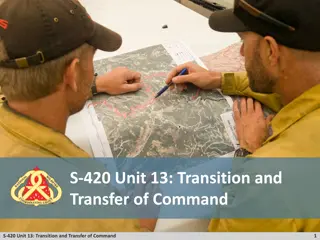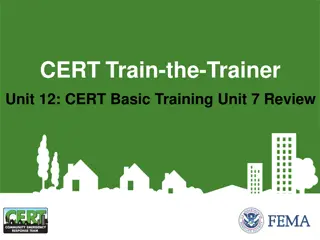Comprehensive Overview of CERT Basic Training and Incident Command System (ICS)
Neighborhood organizations and individuals can benefit from CERT Basic Training, learning about Disaster Preparedness, Medical Operations, Fire Safety, and more. The Incident Command System (ICS) provides a systematic approach to emergency response, emphasizing scalability and common terminology. The history of CERT dates back to the 1985 Mexico City earthquake, emphasizing the importance of civilian training. On-scene management with CERT focuses on efficiency, worker safety, clear leadership, and effective rescue efforts.
Download Presentation

Please find below an Image/Link to download the presentation.
The content on the website is provided AS IS for your information and personal use only. It may not be sold, licensed, or shared on other websites without obtaining consent from the author.If you encounter any issues during the download, it is possible that the publisher has removed the file from their server.
You are allowed to download the files provided on this website for personal or commercial use, subject to the condition that they are used lawfully. All files are the property of their respective owners.
The content on the website is provided AS IS for your information and personal use only. It may not be sold, licensed, or shared on other websites without obtaining consent from the author.
E N D
Presentation Transcript
CERT Organization CERT Core Class 997 Cedar 8 June 2023 Bill Springer and Steve Greenberg Version: 05 June 2023
Core CERT Classes (CERT Basic Training) Unit 1: Disaster Preparedness Unit 2: CERT Organization Units 3 and 4: Disaster Medical Operations 1 and 2 (cache req t) Unit 5: Disaster Psychology Unit 6: Fire Safety and Utility Control (cache req t) Unit 7: Light Search and Rescue (cache req t) Unit 8: Terrorism and CERT CERT Basic Training Unit 2: CERT Organization 2-1
Neighborhood Organization A group of neighbors can organize to help themselves in a disaster (and other times) To be efficient and effective, the group needs to have training to know how to best proceed There is an existing methodology that is proven to work and is used by first responders such as the fire department It is the Incident Command System (ICS) and can be used by a neighborhood CERT CERT Basic Training Unit 2: CERT Organization 2-2
What is the Incident Command System (ICS)? Systematic tool used for the command, control and coordination of emergency response. Fully scalable (small to large to small) Uses a common terminology CERT Basic Training Unit 2: CERT Organization 2-3
Why CERT? 1985 Mexico City earthquake: 100 civilians were killed trying to assist rescue efforts The need for training civilians was recognized The CERT concept was created by Los Angeles City Fire Department (LAFD) in 1985. FEMA and Citizens Corps adopted the west coast CERT model as nationwide standard CERT Basic Training Unit 2: CERT Organization 2-4
Purposes of On-scene Management Do the most good for the most people most efficiently! Maintain the safety of disaster workers Provide clear leadership and organizational structure Make rescue and care efforts effective CERT Basic Training Unit 2: CERT Organization 2-5
How to Accomplish those Purposes with CERT Well-defined management structure Effective communication Common terminology Action plans Resource management Accountability CERT Basic Training Unit 2: CERT Organization 2-6
Objectives for CERT Management Identify scope of incident Determine overall strategy Deploy resources Document actions and results CERT Basic Training Unit 2: CERT Organization 2-7
Important ICS Concepts Chain of Command Unity of Command Span of Control (S.O.C.) CERT Basic Training Unit 2: CERT Organization 2-8
CERT Incident Command System First person to arrive on scene or at the command post. Incident Commander Finance & Admin Logistics Planning Operations Directs & coordinates teams: Damage assessment Fire suppression Search and rescue Medical operations Resources, situation status, action plans, & documentation: Signing people in and out Referring people to Ops Shift change management Provides and tracks equipment, supplies and facilities: Cache equipment Other equipment Supplies Location for IC post Location for medical Tracks Costs and Time CERTs don t usually need! 2-9 e
E.g. of Span of Control (how many people report to one person) 3 to 7 reports - Operations S&R= Search and Rescue CERT Basic Training Unit 2: CERT Organization 2-10
CERT Mobilization Take care of yourselves, your families, homes, and neighbors Proceed to predesignated staging area Establish Incident Command, organize the team Collect info; sign in resources; Document! Develop Action Plan; Deploy Resources Organization evolves based on new information & resources CERT Basic Training Unit 2: CERT Organization 2-11
CERT in Action Video 2-12
Break! 10 minutes CERT Basic Training Unit 2: CERT Organization 2-13
Documentation Write it down! CERT Basic Training Unit 2: CERT Organization 2-14
Documentation Section Chiefs (Ops, Planning, Logistics) Provide Command Post with information Command Post Document the situation status Incident locations Access routes (teams into the neighborhood) Identified hazards (downed wires) Support locations (med treatment area(s)) IC Report Status to Professional Responders: Fire, Police, Medical, Public Health, Office of Emergency Services CERT Basic Training Unit 2: CERT Organization 2-15
Documentation If it wasn t written down Write it down! It didn t happen CERT Basic Training Unit 2: CERT Organization 2-16
CERT ICS Documentation: Forms Damage Assessment (CERT Form #1) Personnel Resources Sign-In (CERT Form #2) Incident/Assignment Tracking Log (CERT Form #3) Briefing Assignment (Instructions to Team) (CF #4) Victim Treatment Area Record (CERT Form #5) Communications Log (CERT Form #6; ICS 309) Equipment Inventory (CERT Form #7; ICS 303) General Message (CERT Form #8; ICS 213) Pad of paper ( CERT Form 0 ) CERT Basic Training Unit 2: CERT Organization 2-17
Documentation Flow First person to arrive is Incident Commander Doesn t have to remain IC depending on who arrives later CERT Basic Training Unit 2: CERT Organization 2-18
Initiation of CERT Organization Planning CERT Members arrive Sign-in! IC assigns Section Chiefs: Operations, Logistics, Planning Damage Assessments Gathered (or DA teams formed) CERT Basic Training Unit 2: CERT Organization 2-19
Briefing by IC, Team Assignments Operational Teams Set up: - Damage Assessment - Medical - Search and Rescue - Fire Suppression Planning Briefing Assignmt Ops Teams CERT Basic Training Unit 2: CERT Organization 2-20
Medical: Record Victims & Treatment Ready to receive and triage Planning Medical Operations Ops Teams CERT Basic Training Unit 2: CERT Organization 2-21
Logistics: Equipment/Supplies/Facilities Scribe Logistics Planning Medical Operations Ops Teams Ready to deploy CERT Basic Training Unit 2: CERT Organization 2-22
Tabletop Exercise! Locate and set up your Incident Command Post (ICP) Break into tables of 4 persons and assign roles: Incident Commander Operations Section Chief Communications Officer Scribe Assume Logistics has provided all supplies & equipment You will receive damage assessments during the exercise. You have to address them. And SV means Spontaneous Volunteer: a walk-up CERT Basic Training Unit 2: CERT Organization 2-23
Tabletop Role Descriptions Incident Commander: Has overall responsibility for the neighborhood response. Maintains awareness of the situation. Decides what to do and when to do it. Is Safety Officer if no other has been designated. Operations: Responsible to organize volunteers into field teams based on skills. Forms teams and knows where the volunteers are at all times. Map. Communications: Conduit between IC and field teams; passes written and oral messages. Keeps Communications Log. Scribe: Maintains Incident Status Board. Status Board info will be given to IC to report. CERT Basic Training Unit 2: CERT Organization 2-24
Tabletop Rules IC may ask for advice from the Command Team, but IC is the only one to make decisions. Don t second-guess your IC. You are to work only with the information given you. Safety first Greatest good for the greatest number Save questions for the debriefing Have fun! CERT Basic Training Unit 2: CERT Organization 2-25
Tabletop Debrief CERT Basic Training Unit 2: CERT Organization 2-26
Summary ICS provides flexible means of organization Is it safe for team members? Document and communicate information to all CERT levels Provide Command Post with ongoing information about damage assessment, group status, and needs Command Post documents and tracks situation status CERT Basic Training Unit 2: CERT Organization 2-27
Basics of Establishing Your Neighborhood ICS Intro to the Incident Command System: ICS-100b and ICS-200b https://training.fema.gov/is/courseoverview.aspx?code=IS- 100.b https://training.fema.gov/is/courseoverview.aspx?code=IS- 200.b Other free FEMA on-line training courses https://training.fema.gov/is/crslist.aspx?all=true Apps for Alerts and Notifications https://www.cityofberkeley.info/ACAlert/ http://www.nixle.com/ 2-28



